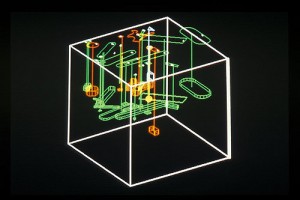Both spiral-wound as well as kammprofile (derived from the German word ''Kamm''=comb) or grooved gaskets are used in various applications such as refineries, petrochemical plants, powert plants etc. Over the past few years, the use of kammprofile gaskets have seemed to gain momentum over the conventional spiral-wound gaskets, since they tend to provide tighter sealing and increased service life.
Spiral-wound gaskets
They basically consist of alternating plies of compressible filler material and a metallic strip (winding) wrapped in a way similar to the grooves of a phonograph record. The most common method for centering this type of gasket is through the use of a metal outer ring. Besides serving the role of centering the gasket, this metal outer ring also limits the gasket's compression. Once the gasket is installed, the filler material is pushed between the plies, thus creating a seal between the flange mating surfaces, also covering any imperfections.
Initially, a common filler material used in gaskets was asbestos. However, due to health-related issues, use of asbestos is no longer allowed and other materials like rubber, PTFE, graphite etc have replaced use of asbestos nowadays.
Spiral-wound gasket dimensions and sizes for ASME B16.5 (flanges up to 24 inches nominal size) and ASME B16.47 flanges (flanges with a nominal size equal or bigger than 26 inches) are stipulated in ASME B16.20 standard (''Metallic gaskets for Pipe Flanges'').
Spiral-wound gaskets present some disadvantages:
- They are very susceptibe to damage and prone to ''springing'' when dropped, bumped or not properly handled.
- Large size gaskets tend to be very dificult to handle, since their windings have a tendency of coming out.
- Quite often, it may be necessary to equip them with inner rings as well. If inner rings are not supplied, then the windings run the risk of buckling, thus considerably reducing the load that can be safely imposed and maintained on them. Adding an inner ring gives an additional compression limiting stop and provides a heat and corrosion barrier protecting gasket windings and preventing flange erosion. It is usual to select inner ring material to be the same as the metal winding.
Kammprofile gaskets
Kammprofile gaskets were first developed in Germany and following DIN 2697 standard approximately 40 years ago. They consist of a solid metal core with concentric serrations and faced with a non-metallic material like graphite, various types of PTFE etc.
Once the gasket is installed, the soft non-metallic material is forced into the metal core serrated grooves. As a result, as the compressive stress increases, multiple concentric high-pressure seals are created along the gasket face surface.
Brief comparison
Unlike a spiral-wound gasket, all of the compressive force is exerted on the kammprofile graphite facing, thuse resulting in a very tight seal. Since the kammprofile is basically solid metal, as opposed to alternating plies of metal and filler applied at spiral-wound gaskets, it is extremely resilient and easy to handle even in large diameters.
Kammprofile gaskets compress significantly less than spiral-wound gaskets, approximately in the order of 0.022 inches in comparison to average 0.050 inches for spiral-wound gaskets. As a result, kammprofile gaskets load more quickly with reduced risk of non-parallel flanges.
Price-wise, kammprofile gaskets are significantly more expensive. However, their increased upfront costs can be compensated by avoiding costly, unscheduled outages and loss of production.
Spiral-wound gaskets may have a small advantage in case the mating flanges are too close and if the gasket is expected to be susceptible to mechanical damage or abuse during installation, since the graphite facing is more vulnerable to mechanical damage. Likewise, in some occasions, spiral-wound gaskets may be more resistant to oxidation, since the windings keep the graphite in place and protect it.
On the other hand, kammprofile gaskets are more tolerant to sealing surface defects and seal more effectively in fugitive emissions services.
Summing up, although there appears to be a shift towards the use of kammprofile years in the last years, the choice is not always clear and could finally come down to personal preference.
In any case, when properly manufactured and installed, both gasket types provide reliable seal arrangements.






